Java multi thread programming on cmp system
- 2. Agenda Background Motivation Contribution Working environment Program design and Implementations Measurements Workloads Benchmark Analysis Conclusion Question 2
- 3. Background – quick overview Multi-programming Multi-processing Multi-threading Thread Homogenous CMP system 3
- 5. JAVA Thread API Wait : public final void wait(long timeout, int nanos) Causes the current thread to wait until another thread invokes the method for this object, or some other thread interrupts the current thread, or a certain amount of real time has elapsed Start : public void start() Causes this thread to begin execution; the Java Virtual Machine calls the run method of this thread.
- 6. JAVA Thread API Run : public void run() If this thread was constructed using a separate Runnable run object, then that Runnable object's run method is called; otherwise, this method does nothing and returns. Subclasses of Thread should override this method Stop : public final void stop() An application should not normally try to catch ThreadDeath unless it must do some extraordinary cleanup operation . If a catch clause catches a ThreadDeath object, it is important to rethrow the object so that the thread actually dies.
- 7. JAVA Thread API Sleep : public static void sleep(long millis) Causes the currently executing thread to sleep for the specified number of milliseconds, subject to the precision and accuracy of system timers and schedulers. The thread does not lose ownership of any monitors. Join : public final void join() Waits for this thread to die.
- 8. Motivation Multithreading with JAVA on large problems. For large computation problems, we would like to know how much performance will be improved if we use thread-based programming instead of execute by one process. How multi processors affects when programming with JAVA thread. Advantages and disadvantages of multithread programming with real applications. Gain experiences with JAVA Thread, multi-thread programming, CMP system, and various tools. 8
- 9. Contributions Software : A JAVA program benchmark. Why JAVA? Portability, can easily test on different operating systems. Synchronization Three Workloads (input) modules. Want to see the performance when having multiple processors compute the workloads in multiprogramming environment. 9
- 10. Working Environments Operating Systems Microsoft Window Vista Ubuntu, Linux-based operating system. VMWare virtual machine. Tools and language Eclipse IDE with JAVA JRE 1.6.03, JRE 1.5.0_13 Project hosting at (Google code) Subversion repository URL: http://code.google.com/p/thread-programmingmultiprocessors/ 10
- 11. Working Environments Google code project. 11
- 12. Benchmark Three input(workloads), large problems which can be divided into small sub problems. Trapezoid’s rule Sorting array Fibonacci number 12
- 13. Workloads Trapezoid's Rule To compute the area under the function or Integrate the function by compute the summation of the small rectangular. 13
- 14. Workloads Trapezoid's Rule (cont.) Trapezoid's Rule – An example of the complicate function, a = 0, b = 10 14
- 15. Workloads Trapezoid's Rule(cont.) Trapezoid's Rule – two threads and how they are assigned. 15
- 16. Workloads Sorting Arrays Sorting Random Integer Arrays. Array before sort 8949 -3467 101 -2367 4050 2766 2 Assign a chuck of array to each thread. 8949 -3467 Thread 1 101 -2367 Thread 2 4050 2766 2 Thread 3 16
- 17. Workloads Sorting Arrays (cont.) Sorting Random Integer Arrays. The Array after sort -3467 -2367 2 101 2766 4050 8949 17
- 18. Workloads Fibonacci number the Fibonacci numbers are a sequence of numbers named after Leonardo of Pisa, known as Fibonacci. The first number of the sequence is 0 the second number is 1 each subsequent number is equal to the sum of the previous two numbers of the sequence itself
- 19. Fibonacci number (cont.) F0 0 F1 1 F2 1 F3 2 F4 3 F5 5 The family trees of cows and bees, the Fibonacci series, the Fibonacci Spiral and sea shell shapes, branching plants, flower petal and seeds, leaves and petal arrangements, on pineapples and in apples, pine cones and leaf arrangements. All involve the Fibonacci
- 22. Program Design – UML 22
- 23. Program Implementation Examples of program input rapry@Morphine:~/csc5573/ThreadSim/ java ThreadSim 1 Run workloads with 1 thread(s). Start trapaziod workload... Thread-1 is running trapazoid workload. Start sorting workload... execution time is: 3879000 nanoseconds. Running fibo workload... Done finding fibonacci number. execution time is: 12,192,912,000 nanoseconds. Finished all the workloads. Total execution time is: 12.19874 seconds. 23
- 24. Measurements Number of thread and performance of large problems. Performance in multiple processors environment. Performance in various operating systems Window/Linux and so on. Measurements on: Intel Core 2 Duo, 3.0Ghz, 2G RAM, Vista, Ubuntu Intel Centrino Duo, 1.44Ghz, 2G RAM, Vista Run 3 times and find the average of the total execution time. 24
- 25. Benchmark – 1 Vista JAVA Thread(s) run for each workload Time in seconds 25
- 26. Benchmark – 2 Vista Time in seconds 26
- 27. Benchmark – 1 Ubuntu JAVA Thread(s) run for each workload Time in seconds 27
- 28. Benchmark – 2 Ubuntu Time in seconds 28
- 29. Results Analysis Benchmark 1 (divide large problem into sub problems) If we assign right number of thread to compute the problems, better execution time. The more thread assign to the problem, the worse performance we get. Benchmark 2 (a pack of workloads) The more thread we assign to compute those problems, the worse execution time we will have. 29
- 30. Results Analysis For a better results we will need CPU Intensive application Need very large problem to compute in order to see an improvement. I/O Intensive application See significantly improvement of execution time. Example. 30
- 31. Conclusion JAVA Threads Advantages Better interaction with user. Exploitation of multiple processors. Do other things while waiting for Slow I/O operations. Simplify object modeling Synchronized, lock objects and classes Inter-thread communication support wait(), notify() 31
- 32. Conclusion(cont.) JAVA Threads Disadvantages Memory resources Two stacks assigned by JavaVM One is used to keep track of java method calls and vars. The other stack is used to keep track of native code calls Processor resources Overhead, context switch Thread operations (start, stop, destroy). When adding additional threads to the design of a system, these costs should be considered. 32
- 33. Conclusion(cont.) JAVA Multi-thread programming Less effective in single processor? Need to assign right number of thread, more thread doesn’t mean good. No synchronization need. No critical section in the program. Effective when the problem require intensive I/O operation. Programmer has to know the problem well in order to use thread-based programming to archive the maximum. utilization of system resources. Easy to start, tough to master. Auto-garbage collection Tasks such as getting lock, releasing lock are simplified. 33
- 34. References [1] JAVA Standard Edition 6 API, Sun Microsystems, http://java.sun.com/javase/6/docs/api/, 2006 [2] Eclipse IDE, www.eclipse.org, 2008 [3] Paul, H., Java Thread Programming, 1999 [4] Scott O., Henry W., Java Threads 2nd edition, 2001 [4] Operating System Concepts, by Silberschatz. Galvin, and Gangne, 7th Edition , Wiley 2005. Fibonacci, http://britton.disted.camosun.bc.ca/fibslide/jbfibslide .htmhttp://en.wikipedia.org/wiki/Fibonacci_number 34
- 35. Question 35

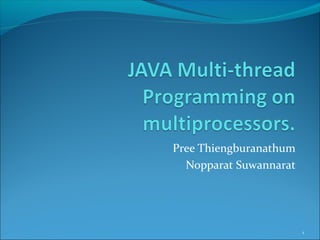





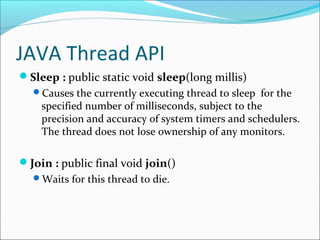
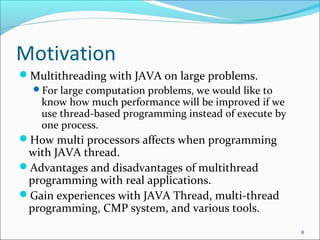
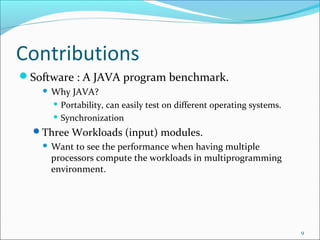
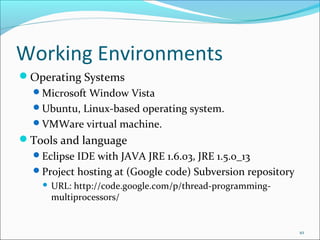
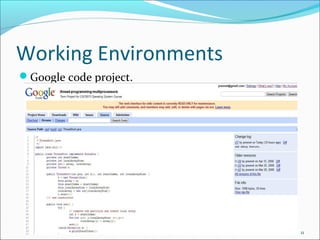
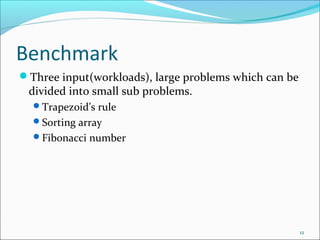
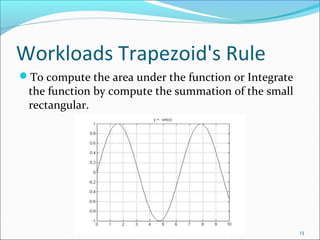





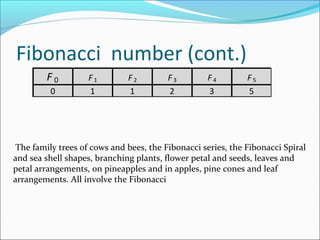

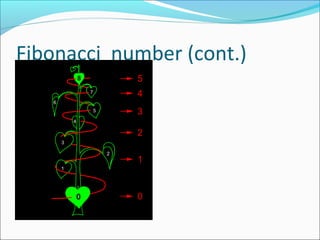


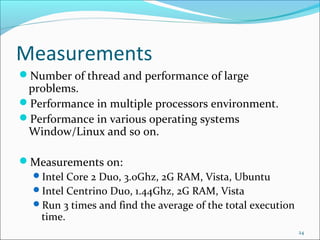



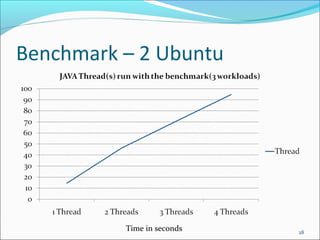


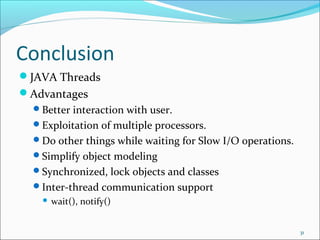

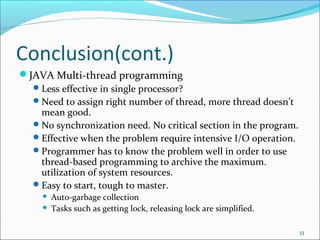
![References
[1] JAVA Standard Edition 6 API, Sun Microsystems,
http://java.sun.com/javase/6/docs/api/, 2006
[2] Eclipse IDE, www.eclipse.org, 2008
[3] Paul, H., Java Thread Programming, 1999
[4] Scott O., Henry W., Java Threads 2nd edition, 2001
[4] Operating System Concepts, by Silberschatz.
Galvin, and Gangne, 7th Edition , Wiley 2005.
Fibonacci,
http://britton.disted.camosun.bc.ca/fibslide/jbfibslide
.htmhttp://en.wikipedia.org/wiki/Fibonacci_number
34](https://image.slidesharecdn.com/javamulti-threadprogrammingoncmpsystem-140222054302-phpapp01/85/Java-multi-thread-programming-on-cmp-system-34-320.jpg)
